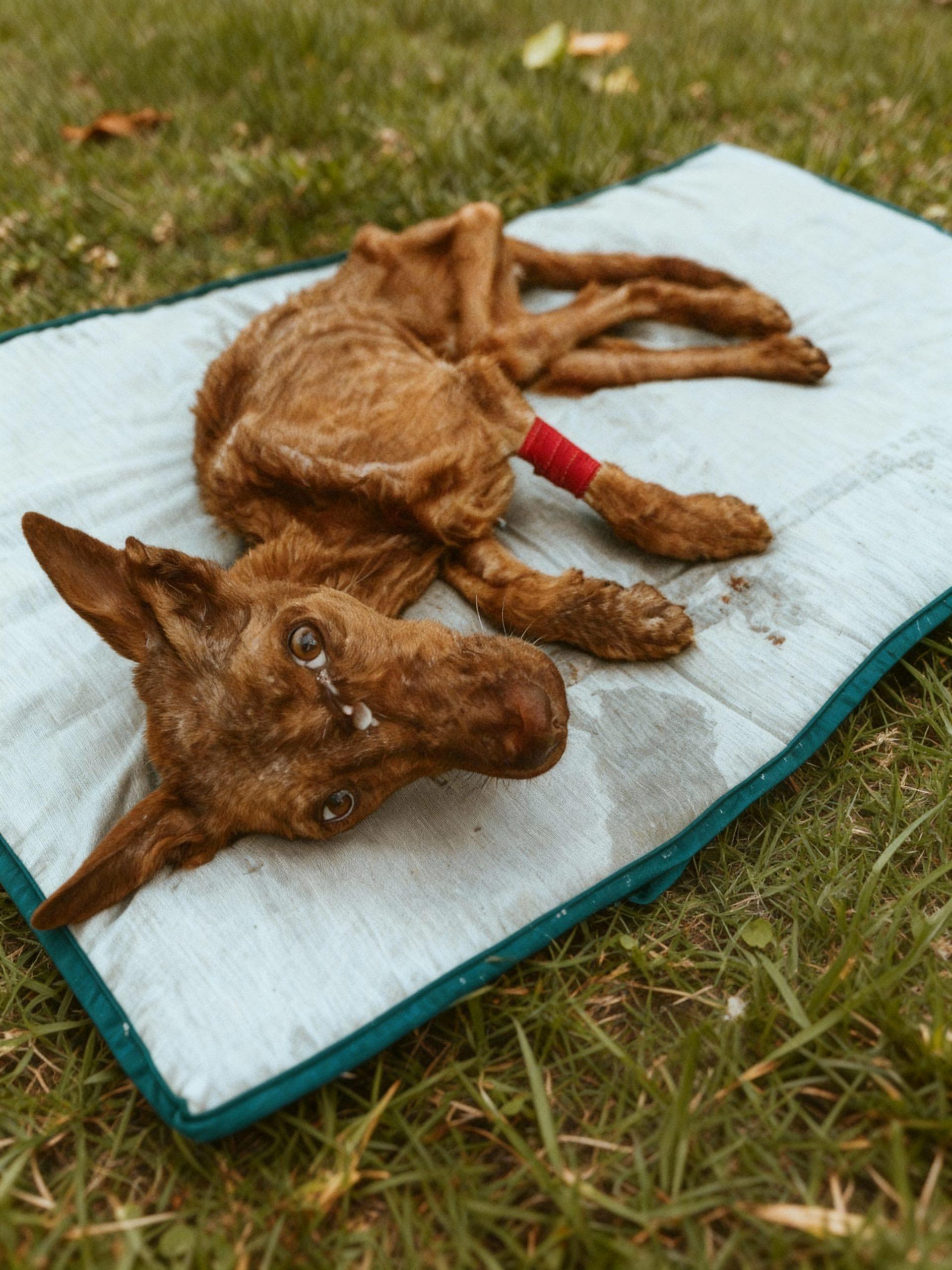The image before us is a poignant testament to the fragility of life and the profound impact of human actions, or inactions. It captures a moment of raw vulnerability, showing a severely emaciated dog lying on a makeshift bed, its fur matted, bones visibly protruding, and a small red bandage stark against its frail limb. The dog’s eyes, wide and seemingly clouded with a mixture of pain and resignation, gaze directly at the viewer, imploring understanding and perhaps, a glimmer of hope. A wet patch on the bedding beneath its head hints at tears, or perhaps just the lingering effects of its ordeal. The setting, a grassy outdoor area, suggests a rescue scenario, a moment where a life-threatening struggle has been acknowledged and an attempt at intervention is underway. This single frame encapsulates a narrative of neglect, suffering, and the beginning of a challenging journey towards recovery. It compels us to look beyond the surface, to understand the circumstances that lead to such a state, and to consider the ethical responsibilities we hold towards all living creatures. The stark reality presented here serves as a powerful reminder that behind every statistic of animal cruelty lies an individual story of immense hardship and an urgent call for compassion and action.

The journey from profound neglect to a chance at a normal life is arduous and fraught with challenges, both for the animal and its rescuers. The first critical step often involves immediate medical intervention to stabilize the animal’s condition. This typically includes addressing severe dehydration and malnutrition, which can lead to organ failure if not managed carefully. Intravenous fluids, administered slowly and judiciously, are essential to rehydrate the animal without overwhelming its compromised system. Nutritional rehabilitation must also be gradual, starting with small, frequent meals of easily digestible food specifically formulated for recovery from starvation. Overfeeding too quickly can be as dangerous as starvation itself, leading to refeeding syndrome, a potentially fatal shift in fluid and electrolyte balance. Beyond these immediate concerns, a thorough veterinary examination is crucial to identify and treat underlying conditions such as parasites, infections, or injuries that may have been exacerbated by neglect. The red bandage on the dog’s leg in the initial image might indicate a wound, an intravenous line, or a point of critical care, highlighting the immediate medical attention this animal received upon rescue. This initial phase of stabilization lays the groundwork for all subsequent recovery efforts.

While physical recovery is paramount, the psychological scars of neglect often run deeper and take longer to heal. Animals rescued from abusive or neglectful environments frequently exhibit a range of behavioral issues, including fear, anxiety, aggression, or extreme timidity. These behaviors are survival mechanisms developed in response to chronic stress and lack of positive human interaction. Building trust with such an animal requires immense patience, understanding, and a gentle approach. Rescuers and foster caregivers play a vital role in this process, creating a safe and predictable environment where the animal can begin to feel secure. This involves consistent routines, positive reinforcement training, and minimizing overwhelming stimuli. Socialization with other calm and well-adjusted animals can also be beneficial, helping the neglected animal learn appropriate social cues. In some cases, professional behavioral therapy or medication may be necessary to address severe anxiety or trauma-related behaviors, facilitating their emotional healing alongside their physical recuperation.

The role of animal rescue organizations and dedicated volunteers cannot be overstated in these recovery efforts. These groups often operate with limited resources, relying heavily on donations and the tireless work of compassionate individuals. They are the first responders, the caregivers, and the advocates for animals who have no voice. Their work extends beyond immediate rescue and medical care; they also undertake the crucial task of finding suitable foster homes and ultimately, forever homes for these animals. Foster parents provide a crucial bridge between the shelter environment and a permanent family, offering individualized care, continued socialization, and a loving home setting that aids in the animal’s transition. Without these organizations and their networks of volunteers, countless animals like the one in the initial image would never get a second chance at a life filled with comfort and affection.

Preventing animal neglect and abuse requires a multi-faceted approach involving education, legislation, and community engagement. Raising public awareness about responsible pet ownership, the signs of neglect, and the resources available for reporting cruelty is fundamental. Educational programs in schools and communities can instill empathy and respect for animals from a young age. Stronger animal protection laws, coupled with effective enforcement, are also vital to deter potential abusers and ensure that those who commit acts of cruelty are held accountable. Furthermore, accessible and affordable veterinary care, along with spay/neuter programs, can help reduce the number of unwanted animals and alleviate the burden on shelters. Community initiatives that support pet owners facing financial hardship or other challenges can also play a significant role in preventing animals from ending up in neglectful situations. Ultimately, fostering a culture of compassion and responsibility towards animals is key to preventing stories like the one in our initial image from unfolding.







